In 2009, my eclipse chaser activity takes me to Eastern Asia, where the longest (max. duration of 6m 39s) total solar eclipse of XXI century is due to take place. This would also bring my total count of observed eclipses to five: August 1st, 2008 in Siberia (detailed report here), March 29, 2006 in Egypt, (detailed report here), October 3rd, 2005 in Spain (annular: detailed report here), August 11, 1999 in Hungary. This time, the totality path starts over Western India at sunrise, moves on to Bangladesh and then cuts across China from west to east along the Yangtze river valley. After reaching its easternmost point on the mainland over Shaghai, the Moons shandow plunges into the Pacific Ocean where it will skim only a handful of islands in Japan (Iwo Jima) and in Southestern Pacific (Marshall and Cook Islands, Kiribati), It is worth noting that the umbral path stretches across one of worlds most densely populated areas, where many big metropolises (Chongqing, Wuhan, Hangzhou, Shanghai) are located.
Heres the detailed map of the path (courtesy Jay Anderson):
In summer, Southern Asia (from west to east: Pakistan, India, Bangladesh, Indochina, Indonesia, Southern China and Japan) is hit by the wet monsoon, which brings along heavy rains and thick cloud. Southeastern China is only partially affected by this climate pattern: in particular, the Yangtze valley is subject to the so-called mei-yu, a quasi-stationary front that stretches in a southwest-northeast direction from mainland China into the Chinese Sea as far out as most of Japan: this front is responsible for summer rains (also known as plum rains, as they take place around the same time when plums get ripe) in the region, from late June till mid-July. Later on, we have a mix of low pressure incursions and heat waves witth occasional typhoons (which, however, are quite rare at latitudes around 30 °N).
When choosing an observing location, a tradeoff between eclipse duration, logistics and weather prospects has always to be found. Of course, weather stats are of no use for an exact weather forecast at totality, but nonetheless they are one of the few reliable decision-making tools available. In this case, most eclipse chasers (including myself and my trip mates) had chosen Shanghai, which sported the best viewing chances (alightly less than 50%) of all mainland China portion of totality. And yet, these figures make this eclipse the least favorable I have ever tried observing.
Having already observed four eclipses, imaging this kind of phenomenon is nothing new to me. In the past, however, I always took pictures in manual mode, i.e. by taking shots according to a predefined schedule with a plain cable release. For the first time in my eclipse chasing career, however, I decided to use a laptop to control image acquisition with my Canon digital camera.
At first, I had actually thought about going manual with this eclipse too: however, a few things had me change my mind. First off, the outstanding results obtained by Lorenzo Comolli back in 2006 by using a dedicated application, Eclipse Orchestrator by Fred Bruenjes; Lorenzo has plans to use it also for this upcoming eclipse. Then, since the introduction of the Asus EEEPC, the market has been flooded with a wave of very lightweight (less than 1.5 kg) and cheap laptops, called netbooks: their decent computing power, long battery life (up to 5-6 hours) and compact package make them a real bang for the buck and a feast for eclipse chasers looking for portability.
I get my netbook around mid-June, i.e. barely a month before eclipse day. Now I really have to hurry up as theres not much time left for preparation. On the following weekends I perform the necessary tests with Eclipse Orchestrator: however the outcome is very disappointing, as my camera has really big trouble processing the scripted frame sequence. As I really dont have time to look into this problem, I decide to go for a hybrid solution with another program: DSRL Remote Pro. This application also allows for PC remote control, but doesnt offer Eclipse Orchestrators powerful scripting engine: therefore, although most operations can be done remotely, human intervention is still called for to change the camera parameters (e.g. exposure time, image quality, ISO setting, etc). Anyway, all this takes place without ever touching either the camera or the scope.
Eclipse Orchestrator wont go unused, though. Besides its very precise eclipse calculation and real-time graphical rendering functionalities, its script engine also sports a nifty command that can play sound files at precise moments in time, relative to eclipse events (in particular: second and third contact, C2 and C3 respectively). This enables us to play sounds that will act as reminders for important things to do, for example: taking filters off or putting them back on (at C2-40s e C3+40s respectively), starting and finishing the diamond ring bursts (C2 and C3 +/- 20s), or changing any of the cameras settings via DSLR Remote Pro. Heres the summary of my imaging schedule with my main optics (Skywatcher ED80 refractor with a Baader-modified Canon EOS 350D):
Partiality phases: automatic acquisition of one frame per minute with DSLR Remote;
Totality: automatic acquisition of 11-stop bracketed sequences, centered at 1/15 s (which result in all exposure times from 1/500 s to 2s in one-stop intervals);
Second and third contact: 40s bursts (+/- 20s relative to contact time) at a rate of about 3 fps, shot manually by holding down the cable release button with the camera set to continuous mode. The resuting sequences are made up of about 100 frames;
Camera always set to 200 ISO and RAW mode, except for the two bursts when the much faster JPEG mode is used.
Besides traditional prime-focus imaging, my friends and I had planned quite a few other activities:
Eclipse filming with a piggyback-mounted video camera;
Taking frames for a time-lapse movie with a fixed-tripod camera equipped with a wide-angle 10-mm lens stopped down to f/8: an automatic timer would shoot a picture every 15 s in Av mode;
Measuring such environmental parameters as pressure, temperature, humidity with a portable weather station (sampling frequency around 15-20s);
Measuring ambient light with a luxmeter;
Imaging the solar corona with a polarizer filter.
However, as well see shortly, we didnt manage to perform most of the originally planned activities.
Now, lets go back to the most dreaded eclipse chaser bugaboo: the weather. Around mid June I start a careful monitoring activity of weather conditions for China and, above all, Shanghai. On June 20th, a local newspaper, Shanghai Daily, announces the plum rain season, expected to last about three weeks with lower than average precipitation. In early July I draw up a precious list of links to meteo web sites of different kinds (real-time monitoring, satellite imagery, numerical weather prediction, etc) that will come in handy for short-term planning in the field. As expected, around July 10th the plum rains are over, and a strong high pressure field sets in that will bring a spell of good weather and scorching temperatures (up to at least 40 °C) over the whole Yangtze valley. On July 12th, or barely two days before departure, the weather sites start anticipating that a deep low pressure trough will develop around Shanghai right on E-(eclipse) day!. However its still too far ahead in time (10 days) for any forecast to be taken seriously.
Takeoff is on July 14th, when an intercontinental flight takes us from Italy to Beijing where we land the following day, July 15th, There we are welcomed by a hot, muggy weather with a low cloud layer, which seldom lets the Sun shine through; our tour of the wonderful Great Wall takes place in the haze. Then, on July 17th, we visit Tienanmen Square and the Forbidden City under a torrential rain. From July 18th to 20th we move to XiAn, home to to the Terracotta Warriors with clearer skies but equally uncomfortable weather.
Beijing Tien An Men Square under heavy downpours
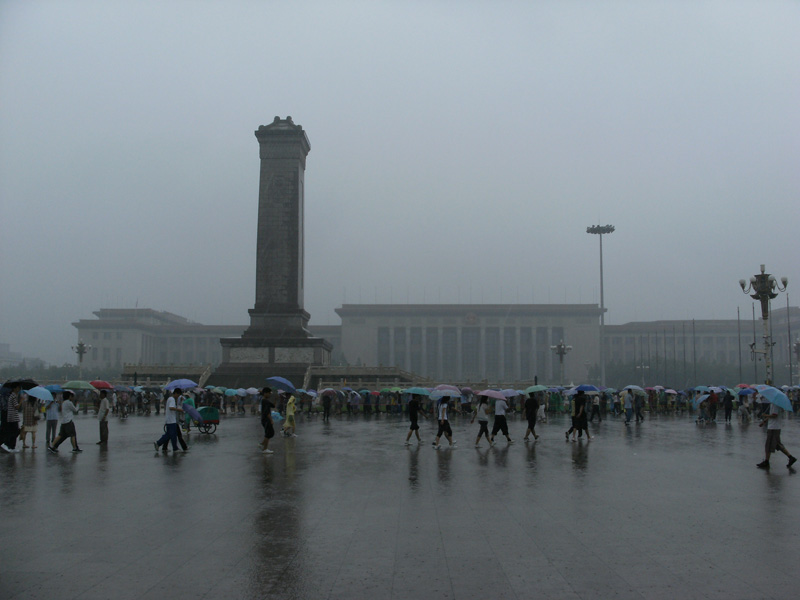
Beijing - The Forbidden City
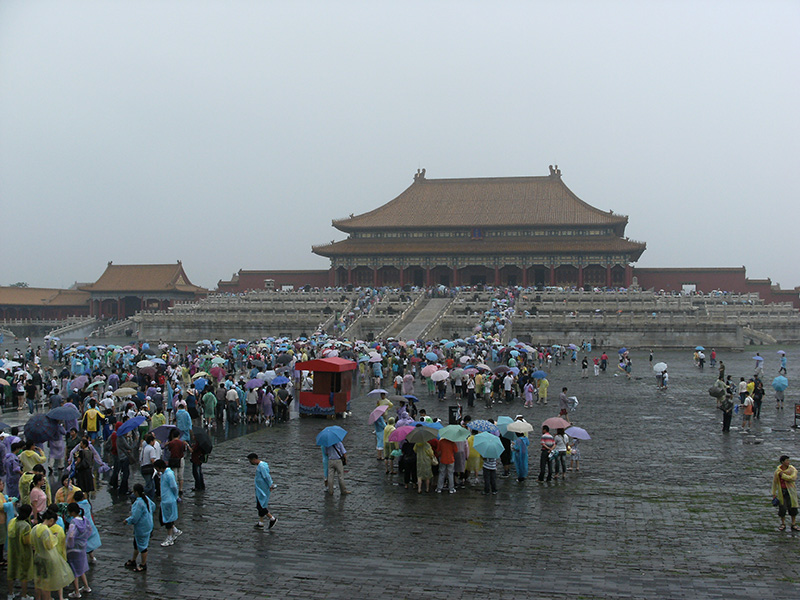
Badaling (100 km NW of Beijing) The Great Wall barely visible through the haze
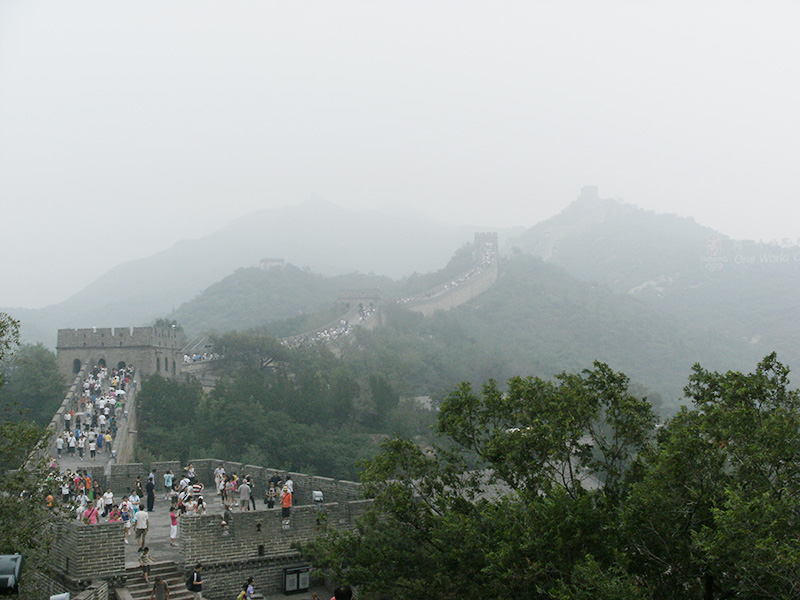
Xi'An - The Terracotta Warrior Army under the huge building
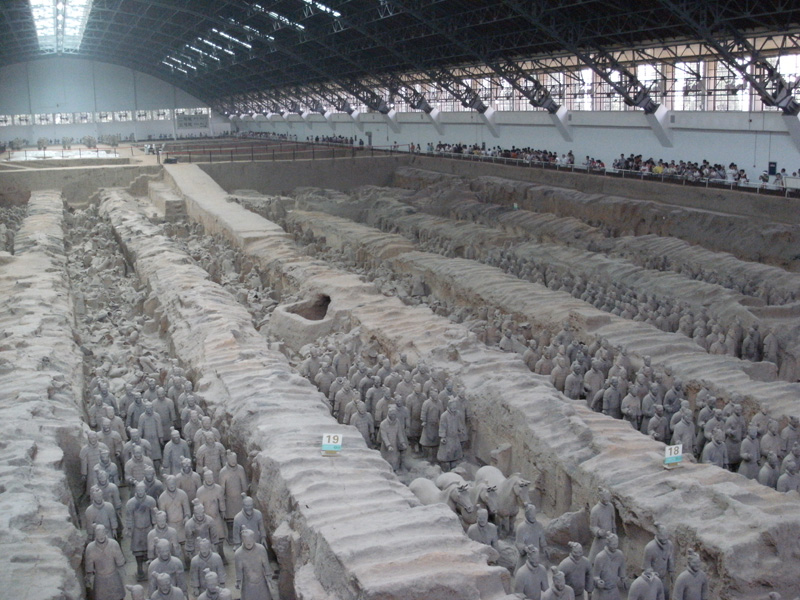
During our stay in Xi'An, when only five days are left to E-day, we really start worrying about the prospects: albeit with some differences, all forecast models do agree that the high pressure field thats been lingering over Central and Southern China will soon collapse, giving way to a low pressure shearline just north of Shanghai. To put it bluntly: crappy weather with thunderstorms and rain over the whole Yangtze valley, and particularly for Shanghai. As we all know, the closer we get to the forecast day, the more likely the forecast is: thats why our concern increases, especially for those, like myself, who think of the eclipse as the main purpose of this journey.
We arrive in Shanghai on July 20th, welcomed by clear and very hot weather (40 °C). In the meantime, in spite of some small discrepancies, all forecast models agree on giving better observing chances to the area between Chongqing and Wuhan. Now a crazy idea starts creeping in my mind: should the weather forecast for Shanghai stay the same, I will try to arrange a lonely raid to Chongqing in search of better weather.
Map of China, where Chongqing, Shanghai and the distance between them are highlighted. The two cities lie more than 1500 km apart as the crow flies.
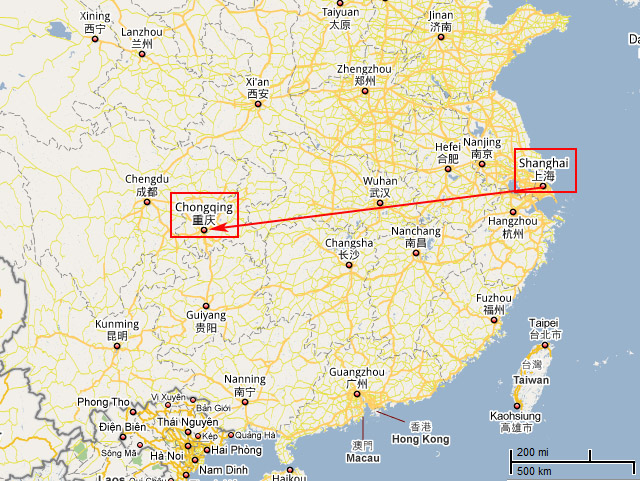
However, this plan poses some risks: China's undoubtedly a modern and advanced country, but it is not so easy for a foreigner to freely wander around alone. These days we spend probably too much time frantically looking at weather maps and satellite imagery, which in turn feeds our concerns of not viewing the event weve traveled all this way for. Later the same day (the 20th), I get to know that the small group of the Astrofili Ferraresi astronomy club, led by Ferruccio Zanotti, happens to be staying in our very same hotel. They plan to get up very early in the morning of July 22th, and to head south/southwest in search of a break in the clouds.
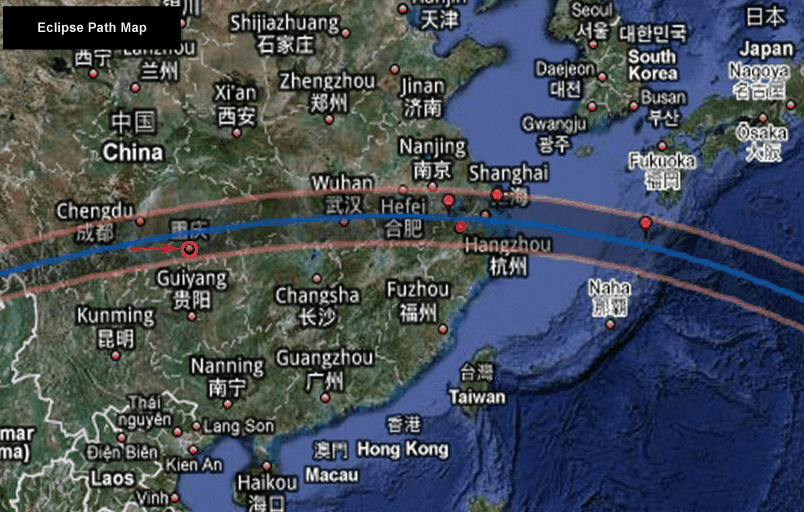
When I wake up in the wee hours of July 21st, I notice that all the available forecast sources (numerical models, local weather services, newspapers) do agree on awful weather prospects for Shanghai :cry: :cry: , with slightly better chances for Chongqing. Thats when I finally make the big decision to leave: during our visit to the Science & Technology park of Shanghai, it just takes me a couple of hours (and quite a few phone calls which will blow my phone bill out of proportion :cry: ) to arrange everything I need. The local agency manages to book the flight and the hotel, while a good friend of mine from XiAn helps me find out a local guide in Chongqing, who will turn out to be extremely professional and helpful. The following 24 hours are so intense, I think its worth taking a closer look at this truly adventurous day!
12.00 pm. After arranging my trip, I rush to my hotel, which lies about 15 km north of the city center, to grab all my hefty gear, which weighs in at more than 40 kg!.
01.00 pm. Heading back from my hotel to downtown Shanghai to pay for my plane ticket which had previously been booked by the agency. In the mean time, I also ring up the other agency in Chongqing to hire the local guide.
03.00 pm. Arrival at Shanghai intl airport. In the waiting hall I come across some other European tourists, and in particular a family of Slovaks who resolved to try their luck in Chongqing, just like myself.
05.50 pm. Takeoff! The flight takes about two hours and a half, and while enroute we are treated with spectacular and worrisome views of huge cumulonimbus clouds which screen any surface details. Just before reaching our final destination, however, the sky is rather clear, in spite of some high cirrus clouds and a thick haze which lies in the lower atmosphere (below 3000 m). Once landed, we also realize that the brightest summer sky stars are visible!
08.30 pm. Just upon arrival I meet a german guy who proudly announces that also Fred Espenak, aka the famous Mr. Eclipse is about to land, and that hell try to do his best to join him for the eclipse. However, I decide to go on my own, as I have a quite complex equipment it takes some time and a quiet place to set up..
10.00 pm. My local guide picks me up from the airport and takes me to my hotel, and we also agree on a list of potential candidate observing sites and a meeting time for the coming morning. Then, I finally have to reprogram my imaging schedule completely, as the timing and the duration of the eclipse for my new location are completely different from whta I had previously configured for Shanghai.
Now, you may (or perhaps may not!) be wondering: did you finally manage to observe this darned eclipse?
...there you go! Well, the answer to this big question is: YES, I made it! I managed to observe it all, although not under the best conditions. Then weve come to the early morning hours of E-day:
01.30 am. After completely reworking my imaging schedule, its time to catch a few Zs.
04.00 am. As planned, the guide comes pick me up at the hotel, and off we go in search of a suitable observing place. After discarding a foothill near the airport cause its too dusty, we take the highway heading north, we take the second or third exit and start driving around in the hilly countryside along between rice fields and orchards. Shortly after, we manage to find a free slope a few meters above the main road, which I consider suitable for observation. The chosen spot is located at: lat. 29.80219° N, long. 106.71958 E and an elevation of around 400 m.
06.00 am. Sunrise. Unfortunately, the sky has since become whitish due to a blanket of high cirrus clouds. The Sun of course is visible, but also because of the low altitude above the horizon, all the exposure times have to be increased by three stops as compared to what I had planned during my tests in Italy
Sunrise over my observing location

08.08 am. At an altitude of about 24°, a small dent appears on the Sun. The eclipse has just begun!
09.13-09.18 am. Woah! Totality! We manage to observe it all over its entire duration. The cirrus clouds prevent us from making out the elusive wisps of the outer corona, while its inner part is clearly visible. In spite of that, we are treated with a breathtaking view, and the presence of this bluish hazy clouds makes it all the more spectacular. Venus can be clearly spotted through the clouds.
10.31 am. Fourth contact: the eclipse is over. In the meantime, our star has risen to about 55 degrees above the horizon: the balmy temperature of totality is long gone and taking apart all the equipment under such a muggy and hot weather turns out to be extremely uncomfortable.
Now let's have a closer look at the eclipse. Here are the local circumstances for my observing location:
The totality phase lasts 4 minutes e 39 seconds, about one minute less than that in Shanghai (5m 30s) and way shorter that its maximum duration (6m39s). Yet, these figures make it my longest eclipse ever!
Mosaic with nine frames at different times (local time): 08:36, 8:45, 8:55, 9:05, 9:15 (totality), 9:24, 9:34, 9:45, 9:56
Diamond ring at second contact. Notice some Bailys beads and the haze by the cirrus clouds
Totality! Digital composite of the solar corona, from 4 frames of 1/15, 1/8, 1/4 e 1/2 s taken from each of 7 sequences, for a grand total of 28 frames; processing by Lorenzo Comolli. Here the corona sports the typical solar activity minimum look.
Diamond ring at third contact (09:18 local time). Here Bailys beads enjoy better visibility.
Detail from the previous image with a close-up on a solar prominence. This incandescent gas arc is about 50000 km across, that is a whopping four times bigger than our planet Earth!!
Complete eclipse animation from about 180 frames. Music (C) Enya
Time-lapse movie of the eclipse from about 400 frames taken with a Canon EOS 300D and a 10 mm Sigma 10 mm lens at f/8. Please note the slow movement and ever changing structure of the thin high clouds. Music (C) Enya
Unfortunately I didn't manage to perform precise environmental measurements, because Id left the instruments (meteorological station and luxmeter) with my trip mates back in Shanghai. I just remember a balmy breeze blowing from south/southeast in the early morning hours, when the air temperature was already hovering around 27-28 °C, and a cooling sensation during totality. The measurements from Chongqing airport station (METAR dispatches), the closest to my location, do not show any significant thermal deviation, as had happened in 2008 at Novosibirsk and Barnaul stations.
Although I didnt have any instruments to measure ambient light with, we can try to make use of the pictures taken with my Canon EOS 300D for the time-lapse movie. All the frames were shot on a fixed tripod in aperture mode (Av), with constant focal ratio and ISO sensitivity; exposure times were figured out automatically by the the camera. If properly calibrated, a DSLR can be used as an illuminance meter; please refer to the following paper from Kodak for details: Estimating Luminance and Illuminance with Reflection-Type Exposure and an 18% Neutral Test Card. Of course, various error factors have to be taken into account in our case:
In spite of all these problems, a closer look at the exposure list shows values from 1/3200 s to 4 s, which cover a brightness range of more than 12000 times. So, we can arrange them all into a graph of exposure versus time (hours) with a logarithmic scale on the Y-axis. As we didnt calibrate our system, an absolute scale is not available, thus we can only express illuminance as a relative factor, with the longest exposure during totality (4 s) set to 1.
Time-lapse exposure time graph
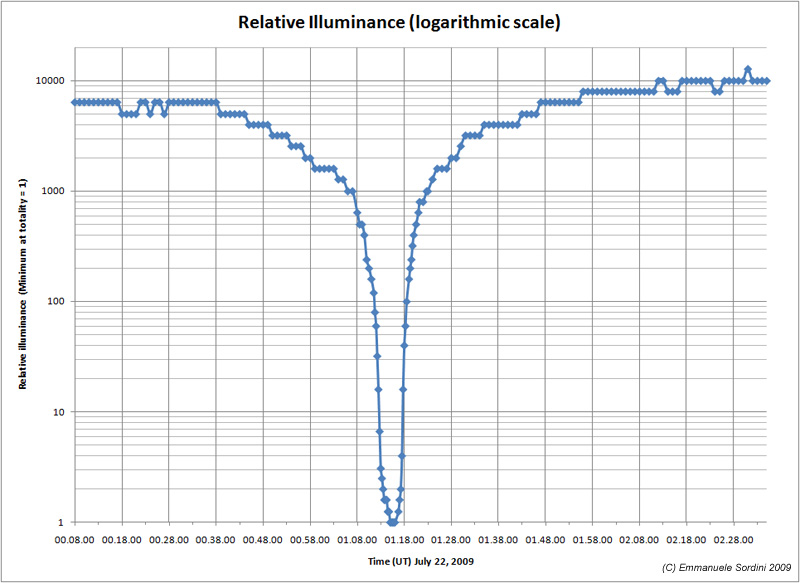
Time-lapse exposure time graph: close-up around totality
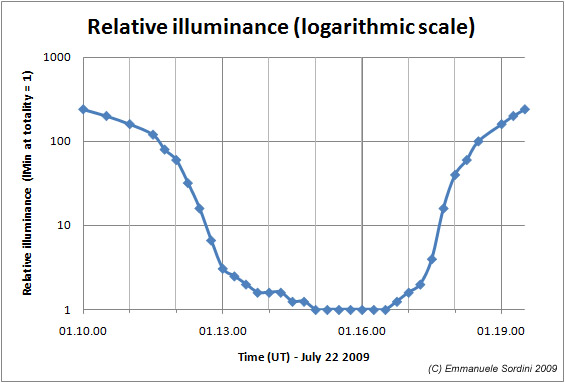
The outcome is quite interesting. The above graph clearly shows a sudden slump in the Suns luminosity which also stands out due to the logarithmic scale on the Y-axis. Here are the last hours moments of my very busy day:
11.30 am. After capturing the last frames (darks, flats, etc) and putting away my equipment, we head back to Chongqing where my guide drives me around in the city center for a quick sightseeing tour. Unfortunately, I am really too tired out to enjoy the visit. In the meantime, I get bad news from the other fellow eclipse chasers I have been keeping in touch with: most of them, including my group, got clouded out; only those who dared to drive away as far as Anji and Hangzhou, managed to get some views of the eclipse through the clouds.
02.00 pm. Arrival at Chongqing airport. I soon learn that my flight to Shanghai has been delayed, but nobody knows by how long. Its time to keep my fingers crossed, as a cancellation would put me in serious trouble: I absolutely have to be back to the hotel in Shanghai tonight, as the following morning we have the return flight to Italy. At the airport I run into a group of Italian eclipse chasers from the Cortina astronomy club, who also made the same last-minute decision to try their odds in Chongqing.
07.30 pm. Take off to Shanghai: fortunately the flight had just been delayed by about two hours..
09.30 pm. Landing at Shanghai airport: one our later I make it to the hotel in one piece. Im really pooped but also very happy to have succeeded in my endeavor and to have pulled off this successful observation in spite the bad odds. Just imagine how it feels like to know that Ill have to get up at 5.20 am the following morning for our trip back to Italy!!
View from my observing location. On the foreground, my equipment. Its a rural zone on the foothills about 40 km NE of Chongqing: cultivation here mainly consist of rice fields and orchards.
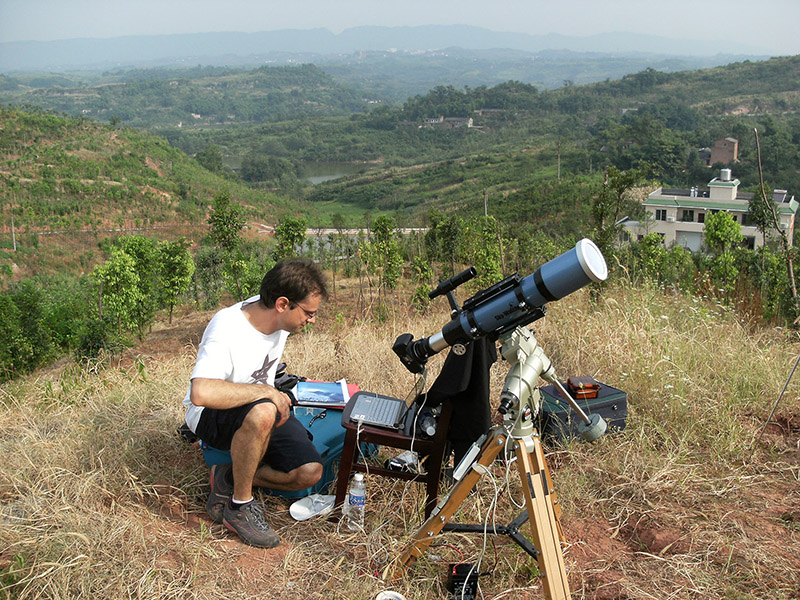
As we saw, I observed and imaged this eclipse under far from ideal conditions, probably the worst ever in my eclipse chasing career. But that doesnt really matter, because it was a wonderful experience that I'll keep really nice memories of for a long time. Of course, I also must admit I kinda lucked out... but, as the ol saying goes fortune favors the brave!!
Anyway, a few things went really well. Computer control worked flawlessly and proved its effectiveness, allowing me to take many more frames that in manual mode: for example, I got seven 11-stop sequences (exposure times from 1/500 s to 2s in one-stop intervals), which makes 77 exposures in total. All pictures, except for those of the bursts at second and third contact, were taken in RAW mode, which is far better than JPEG thanks to its higher dynamic range and the absence of artifacts from lossy compression. In addition to decent quality pictures with the main scope, and I also succeeded in making my first full-fledged time-lapse movie. Prime-focus pictures clearly show that my observing location did not lie on the central line (located about 60 km to the north), since the two contacts did not occur along a disks diameter, but rather in a off-center position (have a look at the Bailys beads pictures on page 2).
For the astronomical point of view, the most interesting achievement is having managed to get decent quality pictures to assemble a digital composite of the solar corona, whose structure is that typically found at solar activity minimums. It must be noted that the corona looks very much like last years solar eclipse: this proves that the situation has not changed significantly over the last 12 months, which is consistent with the long-time lack of sunspots and makes this long quiescence phase rather anomalous.
Also, some facts about Chongqing. First, its dwellers will have the very rare privilege to observe another eclipse in less than six months: this time will be an annular one and will take place on January 15, 2010. Second, this city is known for its crappy climate: very foggy in winter and hot, humid, cloudy, rainy in summer. For those of you that are familiar with Italian climate patterns, the average yearly sunshine time is about 1200 h, which is 40% less than Milan and about half the amount recorded on the Ligurian riviera. Then, to top off, barely ten days after my return to Italy, Chongqing enjoyed a spell of very bad weather that brought along floods with several casualties.
This article couldn't come to an and without some acknowledgements and thanks to:
The heroic eclipse chasers :-)
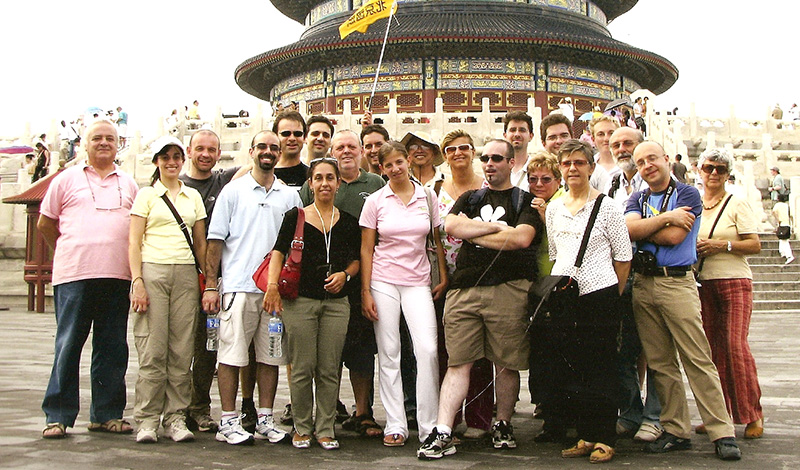
my wishes for the future? I'd like to get a chance to see an eclipse on a clear and shiny day. I'd like to just sit back, relax and enjoy the breathtaking views only eclipses can provide. Without having to resort to dangerous alternatives because of uncooperative weather. Am I asking too much perhaps?
Only time will tell, but for sure I can say this adventure was definitely worth living: every bit, every second, every moment of it!!

Leave a comment